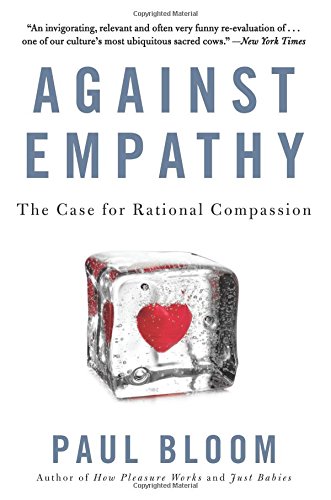Against Empathy details psychological studies and anecdotes that reveal empathy’s flaws and show the weak link between empathy and kindness. While empathy can motivate action, Bloom argues that it is often the wrong action.
Although many people think that greater empathy in decision-making will improve society, Paul Bloom suggests that we reject this idea and instead make moral decisions based on conscious, deliberative reasoning. A professor of psychology at Yale University, Bloom advocates for people to recognize the limits of empathy and the mental distortions it creates. Against Empathy details psychological studies and anecdotes that reveal empathy’s flaws and show the weak link between empathy and kindness. While empathy can motivate action, Bloom argues that it is often the wrong action.
Key quote: “The idea I’ll explore is that the act of feeling what you think others are feeling – whatever one chooses to call this – is different from being compassionate, from being kind, and most of all from being good. From a moral standpoint, we’re better off without it.” – Paul Bloom
Key concepts:
Other People’s Shoes. Emotional empathy (vs. cognitive empathy/social cognition) is a poor moral guide. It has a narrow focus, reflects our biases, and can distract us from consequences and future costs. The thing that “really matters for kindness in our everyday interactions is not empathy but capacities such as self-control and intelligence and a more diffuse compassion” (p. 35).
The Anatomy of Empathy.
- Neural systems demonstrate empathy.
- Empathic responses vary with our biases and associations.
- There is a difference in the brain between “feeling” and “understanding.” In studies there does not appear to be a strong correlation between high levels of empathy and good behavior, nor between low levels of empathy and aggression.
Doing Good. The empathy-altruism connection is a weak one. Psychological studies demonstrate how empathy shines a narrow spotlight on one situation. It can miss the larger context, produce perverse consequences, favor one person to the detriment of others, and in some cases even encourage harm.
The Politics of Empathy. While liberals may lean more on empathic appeals, both conservatives and liberals rely on empathy in decision-making. Emotional empathy relies on an analysis of the immediate implications of the situation in the here and now.
Intimacy. Living in a high state of emotional empathy (“unmitigated communion”) leads to burnout and negative health and other outcomes, and it can derail the ability to act. Whereas living in a state of compassion and loving-kindness (“communion”) leads to positive feelings of warmth, kinder behavior, and more effective helping. There is some kind of balance to be found between necessary partiality towards those we love and also caring for strangers.
Violence and Cruelty. Empathy can short circuit a reasoned cost-benefit analysis of things like war and criminal law and violence. “It’s not true that those who do evil are necessarily low in empathy or that those who refrain from evil are high in empathy” (p. 208).
Age of Reason. Debates over “hot” versus “cold” reasoning and gut feeling versus deliberation all play a part in how humans behave overall. But we do have the ability to be rational. Reason and self-control are legitimate, positive, and meaningful predictors of how well individuals will thrive and how morally they will act.
Defining Empathy
People often use the word empathy to mean being caring, loving, and good. However, the meaning of empathy is “the act of coming to experience the world as you think someone else does” (p. 16).
Bloom separates empathy into two types:
- Cognitive empathy, also called social intelligence, is the ability to understand the emotions another is experiencing without experiencing them yourself.
- Emotional empathy describes feeling the feelings of others. Bloom’s analysis primarily focuses on emotional empathy.
Empathy as a Spotlight
Bloom explains that “you cannot empathize with more than one or two people at the same time” (p. 33). You can value the lives of multiple people all around the world at once, but you can’t empathize with them all at once.
Bloom explains that “you cannot empathize with more than one or two people at the same time” (p. 33). You can value the lives of multiple people all around the world at once, but you can’t empathize with them all at once.
Empathy directs our attention like a spotlight toward identifiable victims rather than statistical findings or cost-benefit analyses. Empathy can make the suffering of one matter more than the suffering of a thousand (p. 99). For instance, we feel more grief when a family member becomes ill than we do when we think about the thousands of children who die every day from hunger.
Feeling empathy for one person can violate moral principles, such as fairness. Psychologist C. Daniel Batson and his colleagues told study participants about a ten-year-old girl named Sheri Summers with a fatal disease. Participants were told that they could move Sheri to the front of the waiting list for treatment. When asked what to do, participants held that Sheri should wait in line, as other children needed the treatment too. However, when asked to first imagine what Sheri felt, participants chose to move her to the front of the line ahead of other children (p. 25).
We can use empathy’s limitations to our own advantage in two ways:
- We can use stories of identifiable victims to persuade others, whether our goal is increased charitable donations or favorable organizational policy.
- We can prevent our own decision-making fallacies by focusing on rational decision models based on fairness instead of anecdotes driven by emotion.
Empathy Exacerbates Existing Bias
Bloom says “whether or not you feel empathy depends on prior decisions about who to worry about, who counts, who matters – and these are moral choices” (p. 70). Our existing biases determine with whom or what we empathize. For instance, you are likely to feel less empathy for people who have cheated you versus people who have been fair to you.
In fact, “empathy distorts our moral judgments in pretty much the same way that prejudice does” (p. 31).
Empathy Alerts, We Choose Our Response
The relationship between empathy and goodness is weak (p. 42). While empathy can alert you to the suffering of others, you choose how to react. Kindness is a choice.
For example, if you feel sad passing a homeless person on the street, you can choose to act upon this empathic feeling in a variety of ways: take a new route to avoid seeing the person, give the person money, or give to a nonprofit fighting to end homelessness.
Empathy can make good people better, “because kind people don’t like suffering, and empathy makes this suffering salient” (p. 76).
Empathy and Violence
Empathy does not block dehumanization, objectification, or violence from occurring. Rather, empathy often directs violence to those with whom we do not empathize or those whom we believe are morally wrong. For instance, empathy for victims can drive violent action against offenders: “our empathy for those close to us is a powerful force for war and atrocity toward others” (p. 9).
More often, violent actions don’t reflect a lack of empathy, but rather a lack of self-control.
Rational Compassion as an Alternative to Empathy
Bloom argues that rational compassion will increase kindness and improve the world. Bloom’s descriptions of rational compassion mirror utilitarianism, or the theory that people should choose actions that maximize utility (or wellbeing) for society.
Bloom’s rational compassion requires self-control and intelligence. Self-control allows us to abstain from our immediate desires to focus on long-term consequences, while both intelligence and self-control together help us to weigh the costs and benefits of decisions on multiple stakeholders.
Given the limits of empathy and the distortions it creates, Bloom suggests that it is futile to try to increase our feelings toward dispersed stakeholders. Instead, rational compassion helps us to check the importance we place on our own lives.
The act of “doing actual good, instead of doing what feels good, requires dealing with complex issues and being mindful of exploitation from competing, sometimes malicious and greedy, interests” (p. 101). In Bloom’s view, leaders make better decisions when using rational compassion.
Finally, Bloom wraps up as he started. His book strongly cautions against emotional empathy’s helpfulness in moral decision-making, but he makes a point of describing the good empathy can do in the right circumstances and the pleasure it brings to share in another’s feelings of joy. As an example, Bloom poignantly describes parenthood and the experience of feeling again, through our children, what it is like to try ice cream or ride a roller coaster for the first time.

Bloom argues that rational compassion will increase kindness and improve the world. Bloom’s descriptions of rational compassion mirror utilitarianism, or the theory that people should choose actions that maximize utility (or wellbeing) for society.
Bloom, P. (2015). Against Empathy: The Case for Rational Compassion. New York: HarperCollins Publishers.
